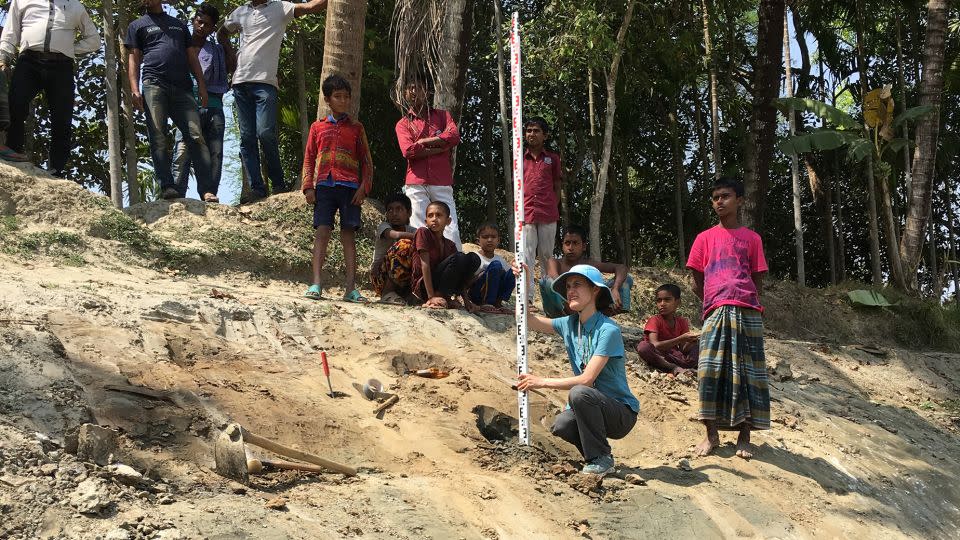Sign up for CNN’s Wonder Theory science newsletter. Explore the universe with news about fascinating discoveries, scientific developments and more.
Earthquakes, caused by the shifting of the Earth’s tectonic plates, have the potential to reshape the face of the world. Now, for the first time, scientists have evidence that earthquakes can reroute rivers: it happened to the Ganges River 2,500 years ago.
The Ganges winds its way from the Himalayas and flows through India and Bangladesh, its waters merging with the Brahmaputra and Meghna rivers. By the time it empties into the Bay of Bengal, it has formed the world’s largest delta system, carrying more water than any other river system on the planet except the Amazon and the Congo.
The Ganges Delta is “a really exciting place to work because it has these big, dynamic riverbeds,” said Dr. Elizabeth Chamberlain, lead author of a new study published June 17 in the journal Nature Communications.
She and her colleagues explored the delta region about 100 kilometers south of Dhaka, the capital of Bangladesh, using satellite maps and digital elevation models that showed the valley-like channels where the river once flowed.
“It is normal for rivers to move completely from one place in the landscape to another. This is a process called avulsion,” said Chamberlain, an assistant professor in the department of environmental sciences at Wageningen University & Research in the Netherlands.
The scientists looked for evidence of this slow, steady erosion process in the Ganges Delta, but found evidence of something much more dramatic in the distant past, hidden in grains of sand.

Earthquakes cause ‘sand volcanoes’
After a day of work, the researchers saw a pit on the side of the road as they were driving back to their hotel. “Because it had just been dug, we could see the stratigraphy, or layering of the sediments, on the walls, so we jumped in,” Chamberlain said.
The researchers saw 10-foot-long (3-meter) vertical columns of light-colored sand amid the dark mud: a hallmark of a riverbed that has been hit by an earthquake. “The way you get these is that the shaking during an earthquake causes the sand and the mud to move, and the mud moves differently than the sand,” Chamberlain said. “Mud is very sticky and tends to stick together, and the sand grains move more as separate pieces, especially if they’re sitting in water.”
When the sand grains move during an earthquake, they take up more volume. And when those sand grains are compressed by mud, pressure builds. “If that pressure is great enough, the sand can be pushed up through the mud on top of it and essentially create a sand volcano,” she said.
In a July 2016 study, Dr. Michael Steckler, co-author of the new paper and a geophysicist at the Columbia Climate School Lamont-Earth Observatory in New York, had previously reconstructed the movements of tectonic plates — giant, slow-moving chunks of Earth’s crust and upper mantle — that are responsible for earthquakes in the Ganges Delta.
His models showed that the likely source of the region’s earthquakes is more than 100 miles (160 kilometers) away from the sand volcanoes Chamberlain and her colleagues found. Based on the large size of the sand volcanoes, the quake would have been at least a magnitude 7 or 8 — close to the size of the great San Francisco earthquake of 1906.


Sediment reveals ancient secrets
To determine how long ago this massive quake occurred, Chamberlain and her colleagues used a method called optically stimulated luminescence. “It takes sand or mud grains and directly measures them and looks at when those sediment grains were last exposed to sunlight,” she said.
When sediment grains are buried, they are exposed to low levels of radiation, which they store as energy. Chamberlain and her colleagues worked in a dark room to avoid contaminating the sediment samples with light. They used a tool to measure how much radiation the grains were exposed to, revealing how long ago the sediments were buried by the earthquake. The researchers calculated that the sand volcanoes formed 2,500 years ago.
About 50 miles (85 kilometers) from the sand volcanoes, the scientists also found a large river channel that filled with mud at about the same time. This finding indicates that the river’s course changed dramatically 2,500 years ago. The proximity of these events in both time and space suggests that a massive earthquake 2,500 years ago caused this diversion of the Ganges.
“From an engineering standpoint, this is something we’re very concerned about, the stability of our waterways,” said Dr. Jonathan Stewart, a professor of civil and environmental engineering at UCLA who was not involved in the project. He said the study was “useful from a number of perspectives,” providing more information about how often large earthquakes occur in Bangladesh and what areas could be affected if another large earthquake were to occur.
Today we are monitoring earthquakes
If a similar earthquake were to strike the Ganges Delta today, more than 140 million people in the area could be affected. “These findings could inform earthquake mitigation and preparedness efforts by highlighting the potential for similar events in the future,” said study co-author Dr. Syed Humayun Akhter, a professor of geology and vice-provost at the Bangladesh Open University.
He noted that both individual actions and government efforts, including investments in seismic monitoring and early warning systems, infrastructure improvements and public education, are necessary to keep people safe if another earthquake occurs.
“These kinds of extreme events don’t happen that often, so we don’t always have a modern record of everything that’s happening with the Earth’s dynamics,” Chamberlain said.
Studies like this, she added, “help us to look into the past and see how the Earth is functioning, or could be functioning over 100,000 years or even longer timescales. And that’s really important to understanding what we have on the surface today and what might happen in the future.”
Kate Golembiewski is a freelance science journalist based in Chicago who goes nuts over zoology, thermodynamics, and death. She hosts the comedy talk show “A Scientist Walks Into a Bar.”
For more CNN news and newsletters, create an account at CNN.com